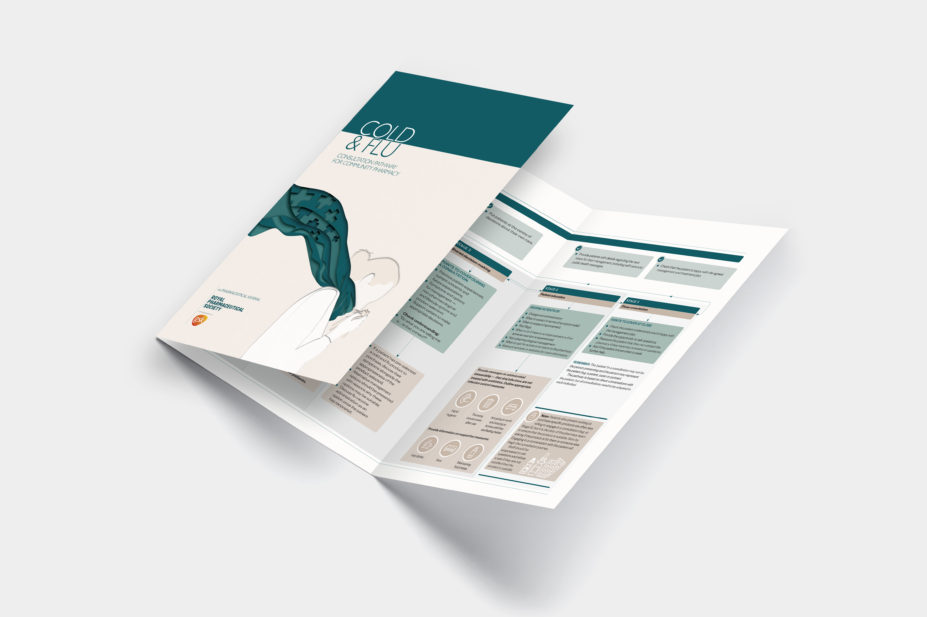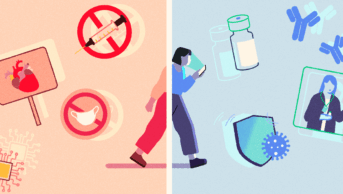
Julie Lee / The Pharmaceutical Journal
Each year, during cold and flu season (October to March), many patients consider pharÂmacy as the first port of call when feeling unwell from symptoms of cold and flu. The Pharmaceutical Journal conducted a survey of community pharmacists in April to May 2019, and 34% of respondents (n=371) reported that 6–10 patients present to community pharmacies every day seeking advice about cold and flu or to purchase an over-the-counter (OTC) product to help relieve their symptoms[1].
With tens of thousands of cold and flu consultations taking place each day, it is not surprising that there is wide variation in practice across the sector[1]. This results in subsequent differences in patient experience and inconsistent expectations of community pharmacy.
A 2017 Ipsos MORI survey asked more than 1,700 people aged 15 years and over what they would do if they had a respiraÂtory tract infection. Just 34% would consider an OTC medicine, and only 11% would approach the pharmacy for advice. For those patients who said they would go to a GP, NHS walk-in centre or out of hours healthcare service, just under 40% of patients said that they would expect to be given an antibiotic[2].
With many patients expecting to receive an antibiotic for a respiraÂtory tract infection, it is necessary for pharmacy teams to consider their role in antimicrobial stewardship (AMS) in the context of cold and flu. This role goes beyond simply challenging inappropriate prescribing of antimicrobials; it must include reshaping patient’s perceptions around cold and flu management[3]. Pharmacists must encourage their teams to reinforce public health messaging around prevention of infection and self-care for cold and flu, and they must strongly discourage patients from automatically seeking antibiotics. To have a positive impact on antimicrobial resistance rates, this change needs to begin at the start of the patient journey — at first presentation.
Although cold and flu are common conditions, their associated complications can be serious or fatal. Even with widespread uptake of the flu vaccine[4], there are an average of 600 flu-related deaths in the UK each year[5].
It is vital that consistent messaging around self-care is delivered by pharmacy teams in order to promote community pharmacy as an accessible point of care and the first port of call for minor conditions.
Pharmacy’s role in the self-care agenda
Conditions that can be self-managed result in an estimated 57 million GP consultations and 3.7 million visits to accident and emergency (A&E) each year, costing the NHS £2.3bn[6],[7].
With increasing numbers of consultations and difficulty fulfilling the demands and expectations of patients, there is a drive to shift more care from hospitals to the community. As a result, people are finding it increasingly difficult to get GP appointments and waiting times are increasing[8].
A survey of 5,011 UK adults aged 18–75 years, conducted by Self Care Nation in 2016, found that most people are aware of the impact that their use of NHS services has. Yet more than one third of survey respondents visited a GP for a minor condition they could have treated either themselves, or with advice from a pharmacist[9]
. In addition, 92% of respondents felt that it is important to take responsibility for their own health to ease the burden on the NHS, but only 29% visited a pharmacy more than once a month, usually to collect a repeat prescription[9].
Since 2016, several campaigns have aimed to raise awareness of the expertise of pharmacists and their teams among the public[10]. There is now a shift towards self-care and an emphasis on promoting the appropriate use of antibiotics and how it supports the AMS role of community pharmacists and their teams.
The development of primary care networks, as well as increases in NHS 111 referrals to community pharmacy through the NHS Urgent Medicine Supply Advanced Supply Service and the Digital Minor Illness Service, could provide the momentum for community pharmacy to engage with patients about self-care. It may also give community pharmacy the opportunity to demonstrate how it can support patients to manage acute minor illness[11].
Involving the patient in decision making
As self-care will be essential to future management of cold and flu, any decisions should be made in collaboration with the patient, taking into consideration their priorities and lifestyle. It is necessary that patients are advised about symptom duration and that they are aware of what actions to take should their symptoms worsen or not improve within the discussed timeframe[1]. Pharmacological and non-pharÂmacological options for self-care should be outlined alongside the red flag symptoms that would require re-presentation or referral.
As patients will be engaged and empowered in decision making about their own care, it provides an opportunity for community pharmacy to discuss AMS. To do this, pharmacists and pharmacy teams need to understand the link between effective management of patients with cold and flu symptoms and effective AMS. The training materials produced in the subsequent parts of this campaign will help bridge the gap between the pharmacy team and patients to help ensure that a consistent level of care is provided across the sector. This will be achieved by outlining how the pharmacy team should approach cold and flu consultations, whether patients present seeking advice or after self-selecting a product. There is an emphasis on aligning the sector with other public health messaging related to the AMS role of pharmacy (e.g. infection control and discouraging inappropriate prescribing and requests for antibiotics).
Moving forward
Now is the time to challenge existing behaviours within community pharmacy and to view self-care, infection prevention and symptoÂmatic relief in the management of cold and flu symptoms in the context of AMS. This will ensure a consistent standard of patient care for cold and flu consultations across the sector.
As medicines experts, community pharÂmacists must recognise the importance of updating their knowledge and to upskill their team as needed, focusing on the quality, rather than the quantity, of training.
Using a ‘train the trainer’ approach, The Pharmaceutical Journal has developed a content package as part of the cold and flu partnership with GSK, which aims to help pharmacists working across multiple and independent community pharmacies to implement a consistent approach and standard of care for consultations with patients presenting to ask advice on how to manage cold and flu symptoms, or after having selected an OTC product.
The training materials will come in three parts and will be published at the beginning of October 2019:
Part one
- An overview of consultation skills, techniques and frameworks.
Part two
- Consultation approaches for cold and flu;
- Defining the roles and responsibilities of each member of the team;
- Focus on practical skills development.
Part three
- Detailed training approaches for the whole team;
- How to implement a training programme and the new standard within your pharmacy.
Citation:
The Pharmaceutical Journal, September 2019, online. doi: 10.1211/PJ.2019.20206985
References
[1] Robinson J. Community pharmacy ‘must provide consistent care’ for cold and flu. Pharm J 2019; Suppl:S2–S3.
[2] Ipsos MORI. Public Health England: Public awareness and opinion survey. 2017. Available at: https://www.ipsos.com/ipsos-mori/en-uk/public-health-england-public-awareness-and-opinion-survey-2017 (accessed September 2019)
[3] Ashiru-Oredope D. Providing self-care advice for cold and flu keeps antibiotics working. Pharm J 2019; Suppl:S5
[4] Public Health England. Seasonal flu vaccine uptake in GP patients: winter 2018 to 2019. Available at: https://www.gov.uk/government/statistics/seasonal-flu-vaccine-uptake-in-gp-patients-winter-2018-to-2019 (accessed September 2019)
[5] Oxford Vaccine Group at University of Oxford. Vaccine knowledge project. Available at: http://vk.ovg.ox.ac.uk/influenza-flu (accessed September 2019)
[6] IMS Health, Minor ailment workload in general practice. 2007.
[7] Self Care Forum. Over 2 million unnecessary A&E visits “wasted”. 2012. Available at: http://www.selfcareforum.org/wp-content/uploads/2011/07/Minorailmentsresearch09.pdf (accessed September 2019)
[8] The Kings Fund. Understanding pressures in general practice. 2016. Available at: https://www.kingsfund.org.uk/publications/pressures-in-general-practice (accessed September 2019)
[9] PAGB. Self Care Nation. Self care attitudes and behaviours in the UK. 2016. Available at: https://www.pagb.co.uk/content/uploads/2016/11/PAGB-SELF-CARE-NATION-REPORT-NOVEMBER-2016-1.pdf (accessed September 2019)
[10] NHS England. Stay Well Pharmacy Campaign. Available at: https://www.england.nhs.uk/primary-care/pharmacy/stay-well-pharmacy-campaign (accessed September 2019)
[11] NHS England. NHS Long Term Plan. Available at: https://www.england.nhs.uk/long-term-plan (accessed September 2019)



